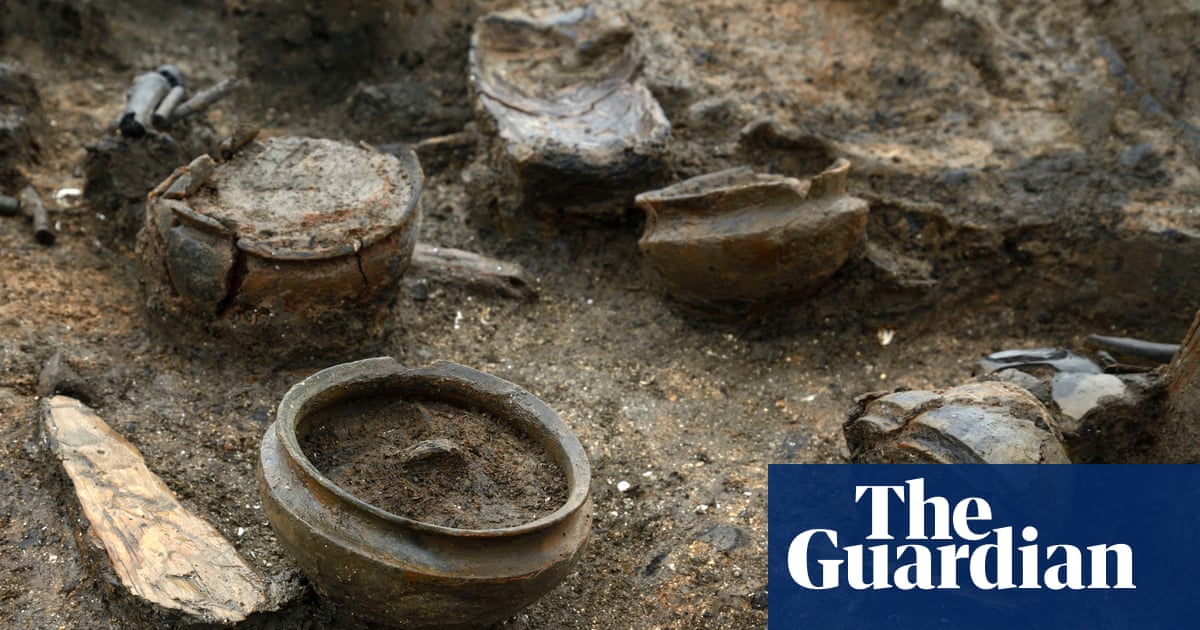A bronze age settlement built on stilts that dropped âlike a coffee plungerâ into a river after a catastrophic fire has provided a window on our past lives, according to the archaeologist that led the investigation of the Cambridgeshire site.
Must Farm, nicknamed the Pompeii of the Fens, offers âexceptional clarityâ because of a combination of charring and waterlogging, said Mark Knight, of Cambridge Universityâs archaeological unit.
On Wednesday, two open-access publications are being launched that comprehensively detail the finds from the excavation at a working brick clay quarry. Next month, some of the preserved objects will go on display at Peterborough Museum in an exhibition that tells the story of bronze age life in the short-lived settlement and its discovery almost 3,000 years later.
Must Farm, which dates to about 850BC, was inhabited for only about nine months before it was destroyed by fire. Its roundhouses were built on stilts over a tributary of the River Nene. The cause of the fire is unknown. The speed at which it took hold gave residents no opportunity to grab their most precious possessions. âIt was get out or die,â said Knight.
As the roundhouses collapsed under the weight of their roofs, jewellery, pottery, clothing, tools and even food that was cooking in pots fell into the muddy river below. Vegetation in the river cushioned their impact, preventing damage; the objects and the wooden structures of the roundhouses sank into silt.
âThe occupants built the [settlement], furnished it, moved in and got settled. And then there was a massive, catastrophic fire. They ran for their lives, leaving everything behind,â said Knight.
The heavy roofs âdropped like coffee plungersâ and everything plummeted into the river below. âLovely soft silts formed around those remains, and then metres of that developed over time before we came back to excavate it. The settlement was pretty much intact, apart from the people who lived in it.â
During the excavation in 2015-16, archaeologists retrieved almost 200 wooden artefacts, more than 150 fibre and textile items, 128 pottery vessels and more than 90 pieces of metalwork. More than 18,000 pieces of structural wood were recorded.
Analysis of preserved food remains showed the settlementâs inhabitants were eating meat stews, dumplings and bread, chops of pork and lamb, and â possibly â honey-basted venison. Personal items recovered included decorated textiles and exotic glass beads.
âEach of the structures was cluttered full of axes, gouges, chisels, razors â a whole range of tools. There were glass and jet and amber necklaces. There was a real sense of a full household inventory and people who were well provisioned,â said Knight.
The settlement dates from the very end of the bronze age, when agriculture was booming. The inhabitants grew wheat and barley and kept sheep, cattle and pigs.
âWe donât have much to compare it with because this level of preservation is so exceptional,â said Knight. âOur understanding is that this is truly representative of what the world looked like in 850BC, as opposed to being an anomaly.â
More than 50 specialists â roughly equal to the settlementâs population â worked on the excavation for a year. The £1.1m cost was met by Historic England and Forterra, the quarryâs owners.
Duncan Wilson, Historic Englandâs chief executive, said: âThe discoveries made at Must Farm are truly astonishing. They have helped to broaden our understanding of life in the bronze age, connecting us directly with communities from the past and helping us to understand a way of life that was more sophisticated than we could have imagined.â










